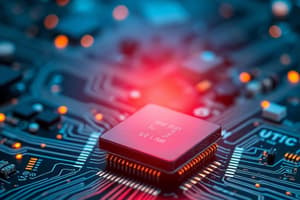Podcast
Questions and Answers
What is a microprocessor and what are its primary functions?
What is a microprocessor and what are its primary functions?
A microprocessor is a single integrated circuit that contains the CPU of a computer. Its primary functions include executing instructions, performing arithmetic and logic operations, and controlling data flow.
How does a microcontroller differ from a microprocessor?
How does a microcontroller differ from a microprocessor?
A microcontroller is designed for specific tasks within embedded systems and integrates additional components like memory and I/O ports, while a microprocessor is more powerful and complex, often requiring external components.
What are the components of a microcontroller?
What are the components of a microcontroller?
The components of a microcontroller include a CPU, memory (RAM and ROM/Flash), I/O ports for interfacing, and peripheral interfaces like ADCs, timers, and communication protocols.
List some examples of microprocessors.
List some examples of microprocessors.
What types of microcontrollers are there based on their architecture?
What types of microcontrollers are there based on their architecture?
Study Notes
Microprocessor
- Definition: A microprocessor is a single integrated circuit (IC) that contains the central processing unit (CPU) of a computer.
- Functionality:
- Executes instructions from programs.
- Performs arithmetic and logic operations.
- Controls data flow in a computer system.
- Components:
- ALU (Arithmetic Logic Unit): Performs calculations and logical operations.
- Control Unit: Directs the operation of the processor.
- Registers: Small storage locations for temporary data.
- Types:
- 8-bit, 16-bit, 32-bit, 64-bit: Refers to the width of the data bus and registers.
- Microprocessors are commonly used in personal computers, laptops, and servers.
- Examples: Intel Core series, AMD Ryzen, ARM processors.
Microcontroller
- Definition: A microcontroller is a compact integrated circuit designed to govern a specific operation in an embedded system.
- Functionality:
- Combines a microprocessor core with memory and peripherals on a single chip.
- Controls devices and processes inputs/outputs.
- Components:
- CPU: Executes instructions and processes data.
- Memory: RAM (volatile) and ROM/Flash (non-volatile) for storing program code and data.
- I/O Ports: Interface for external devices like sensors and motors.
- Peripheral Interfaces: ADC (Analog to Digital Converter), timers, communication protocols (UART, SPI, I2C).
- Types:
- 8-bit, 16-bit, 32-bit: Refers to the architecture and processing capability.
- Widely used in embedded systems like appliances, automotive controls, and medical devices.
- Examples: Arduino (ATmega), PIC microcontrollers, STM32 series.
Key Differences
- Complexity: Microprocessors are more powerful and complex; microcontrollers are simpler and designed for specific tasks.
- Integration: Microcontrollers integrate additional components (memory, I/O ports), while microprocessors typically require external components.
- Applications: Microprocessors are used in general computing; microcontrollers are used in embedded systems and control applications.
Microprocessor
- A microprocessor is a single integrated circuit that serves as the central processing unit (CPU) in a computer.
- It executes program instructions and performs arithmetic and logical operations while controlling data flow in computer systems.
- Key components include:
- ALU (Arithmetic Logic Unit): Responsible for carrying out calculations and logical operations.
- Control Unit: Manages the operations of the processor.
- Registers: Small storage locations used for temporarily holding data.
- Types of microprocessors vary by data bus and register width:
- 8-bit, 16-bit, 32-bit, 64-bit architectures are common.
- Common applications are found in personal computers, laptops, and servers.
- Examples include Intel Core series, AMD Ryzen, and ARM processors.
Microcontroller
- A microcontroller is a compact integrated circuit designed for managing specific tasks in embedded systems.
- Combines a microprocessor core with memory and peripherals on a single chip, making it suitable for controlling devices and managing I/O operations.
- Key components include:
- CPU: Executes instructions and processes data.
- Memory: Comprises RAM (volatile) for temporary data and ROM/Flash (non-volatile) for program storage.
- I/O Ports: Interfaces for external devices like sensors, motors, and other peripherals.
- Peripheral Interfaces: Include ADC (Analog to Digital Converter), timers, and various communication protocols (UART, SPI, I2C).
- Microcontrollers are categorized by architecture and processing capability:
- Common types are 8-bit, 16-bit, and 32-bit.
- Predominantly used in embedded systems such as household appliances, automotive controls, and medical devices.
- Notable examples are Arduino (ATmega), PIC microcontrollers, and STM32 series.
Key Differences
- Microprocessors are characterized by their complexity and power, tailored for more general computing needs, while microcontrollers are simpler, designed for specific tasks.
- Microcontrollers provide higher integration, combining memory and I/O interfaces, while microprocessors typically depend on external components for these functions.
- Applications for microprocessors include general computing needs, whereas microcontrollers are primarily found in embedded systems and control applications.
Studying That Suits You
Use AI to generate personalized quizzes and flashcards to suit your learning preferences.
Description
Explore the fundamental concepts of microprocessors and microcontrollers. This quiz covers their definitions, functionalities, components, and types. Test your knowledge on examples like the Intel Core series and ARM processors.




